Moravia
![]()
The title of this article is ambiguous. For other meanings, see Moravia (disambiguation).
Moravia (rarely also Moravia; from Czech, Slovak Morava [ ![]() ] or Latin Moravia) is (along with Bohemia and Austrian Silesia or Czech Silesia) one of the three historical countries of the Czech Republic, located in its east and southeast. In the 9th century, the territory of Moravia (as well as the adjacent western parts of Slovakia) comprised the core territory of the Moravian Empire. At the beginning of the 11th century Moravia became a land of the Bohemian crown. As the Margraviate of Moravia, the area was administered for centuries as part of the Habsburg Monarchy. In the Czech Republic, to which it belongs today, Moravia is a historical landscape, thus since 1949 it no longer represents a separate administrative unit. Moravia's
] or Latin Moravia) is (along with Bohemia and Austrian Silesia or Czech Silesia) one of the three historical countries of the Czech Republic, located in its east and southeast. In the 9th century, the territory of Moravia (as well as the adjacent western parts of Slovakia) comprised the core territory of the Moravian Empire. At the beginning of the 11th century Moravia became a land of the Bohemian crown. As the Margraviate of Moravia, the area was administered for centuries as part of the Habsburg Monarchy. In the Czech Republic, to which it belongs today, Moravia is a historical landscape, thus since 1949 it no longer represents a separate administrative unit. Moravia's
native name, Morava, comes from that of the territory's main river, the Danube tributary the Morava (Czechoslovak Morava).
On its western flank Moravia is bordered by Bohemia, the largest historical Czech land, and on its northern flank by Czech Silesia, the smallest historical Czech land. Moravia borders Slovakia to the east and Austria to the south.
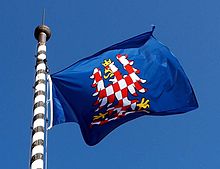
One of the numerous historical, non-official flags of Moravia
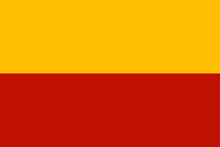
One of the numerous historical flags of Moravia
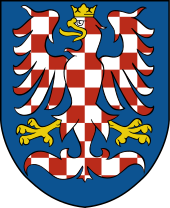
Coat of arms of Moravia (13th century to 21st century)
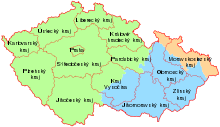
Parts of the Czech Republic: Bohemia Moravia (Czech) Silesia
Geography
Moravia forms the eastern third of the Czech Republic. Not included in Moravia proper are the headwaters of the Odra River from Krnov and Opava towards Ostrava, which historically belong to the Czech part of Silesia.
The Statistical Yearbook of the Austrian Monarchy for the year 1864 gives an area of 403.77 geographic square miles for the country of Moravia, which corresponds to 22,233 km².
Moravia borders Poland and the Czech part of Silesia to the north, Slovakia to the east, Lower Austria to the south and Bohemia to the west. The northern border is formed by the Sudeten Mountains, which merge into the Carpathian Mountains to the east and southeast. The historical border triangle with Bohemia and Austria is located at the top of the Bohemian Sass at the High Stone near Staré Město pod Landštejnem (Three-Country Stone). On the border with Austria flows the strongly meandering Dyje River; in the vicinity of Hardegg is the bilateral National Park Dyje Valley.
The core of the country (altitude 180-250 m) is formed by the sedimentary basin of the Morava River and partly the Dyje River. In the west (Bohemian-Moravian Highlands) the land rises to over 800 m, but the highest mountain is Altvater (1490 m) in the Sudetes, which lies in the northwest. South of this is the Low Jeseníky Upland (600-400 m), which descends to 310 m as far as the upper reaches of the Odra River (Moravian Gate near Hranice na Moravě) and rises further to the Beskydy Mountains at 1322 m (Kahlberg). These three mountain ranges, with the gateway between the last two, are part of the European watershed. The eastern border is formed by the White Carpathians at a maximum of 970 m asl. (Velká Javořina).
Population
A part of the Moravians considers itself as an independent ethnic group with Czech citizenship. According to the last census in 2011, 630,897 people profess to be Moravian (108,423 of them in a linguistic combination, the majority as "Moravian-Czech"). In addition, there are Roma, Slovaks and the long-established Poles. Almost all members of these ethnic minorities have Czech citizenship.
Until 1945, slightly more than a quarter of the population of Moravia consisted of German Moravians. According to the results of the Austro-Hungarian census of 1910, the Czech share of the total population of Moravia at that time (2,622,000 inhabitants) was 71.8% and the German share 27.6%. The German Moravians were largely expropriated and expelled in 1945/46 as a result of the so-called Beneš Decrees.
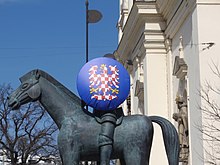
Equestrian statue of Jobst of Moravia on Moravské náměstí (Moravian Square) in Brno. The round shield of the knight was decorated with the Moravian coat of arms on 26 March 2021. Representatives of the city of Brno use it to commemorate the 2021 population, house and housing census in the Czech Republic.
Search within the encyclopedia